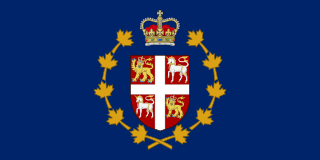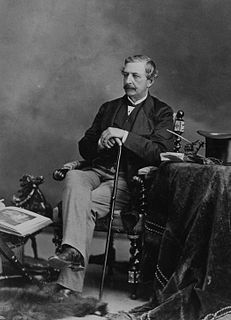
Newfoundland and Labrador is the easternmost province of Canada. Situated in the country's Atlantic region, it is composed of the insular region of Newfoundland and the continental region of Labrador to the northwest, with a combined area of 405,212 square kilometres (156,500 sq mi). In 2018, the province's population was estimated at 525,073. About 92% of the province's population lives on the island of Newfoundland, of whom more than half live on the Avalon Peninsula.
The Order of Newfoundland and Labrador is a civilian honour for merit in the Canadian province of Newfoundland and Labrador. Instituted in 2001, when Lieutenant Governor Arthur Maxwell House granted Royal Assent to the Order of Newfoundland and Labrador Act, the order is administered by the Governor-in-Council and is intended to honour current or former Newfoundland and Labrador residents for conspicuous achievements in any field, being thus described as the highest honour amongst all others conferred by the Newfoundland and Labrador Crown.

The Lieutenant Governor of Newfoundland and Labrador is the viceregal representative in Newfoundland and Labrador of the Canadian monarch, Queen Elizabeth II, who operates distinctly within the province but is also shared equally with the ten other jurisdictions of Canada, as well as the other Commonwealth realms and any subdivisions thereof, and resides predominantly in her oldest realm, the United Kingdom. The Lieutenant Governor of Newfoundland and Labrador is appointed in the same manner as the other provincial viceroys in Canada and is similarly tasked with carrying out most of the monarch's constitutional and ceremonial duties. The current, and 14th, Lieutenant Governor of Newfoundland and Labrador is Judy Foote, who has served in the role since 3 May 2018.
The Orders, decorations, and medals of the Canadian provinces, in which each province of Canada has devised a system of orders and awards to honour residents for actions or deeds that benefit their local community or province, are in turn subsumed within the Canadian honours system. Each province sets their own rules and criteria on eligibility and also how each medal is awarded and presented. Most of the orders allow for the recipient to wear their orders in public, and most grant the recipients the use of post-nominal letters in their names.
Duperron or du Perron is a demonym of the Perron region of northwestern France, and may refer to:

Sir Stephen John Hill,, was a governor of, in turn, four British colonial possessions.
Vice Admiral Francis Pickmore ; naval officer and colonial governor.

Admiral Richard Edwards naval officer and colonial governor of Newfoundland.
James Webb was an officer of the Royal Navy, who served as colonial governor of Newfoundland. He was born in England, and died at Plymouth Sound.
Hugh Bonfoy was a naval officer and colonial governor of Newfoundland.
Joseph de Monic military officer and administrator, acting Governor of Newfoundland, born Oloron, Béarn died Bayonne.
Jacques-François de Monbeton de Brouillan French military officer and Governor of Plaisance (Placentia), Newfoundland (1689-1701) and Acadia (1701-1705).
Louis de Pastour de Costebelle naval officer served as interim governor of Plaisance (Placentia), Newfoundland, before the arrival of Jacques-François de Monbeton de Brouillan in 1690. Costebelle came to Newfoundland as head of a detachment of soldiers in 1687.

By the arrangements of the Canadian federation, the Canadian monarchy operates in Newfoundland and Labrador as the core of the province's Westminster-style parliamentary democracy. As such, the Crown within Newfoundland and Labrador's jurisdiction is referred to as the Crown in Right of Newfoundland and Labrador, Her Majesty in Right of Newfoundland and Labrador, or the Queen in Right of Newfoundland and Labrador. The Constitution Act, 1867, however, leaves many royal duties in Newfoundland and Labrador specifically assigned to the sovereign's viceroy, the Lieutenant Governor of Newfoundland and Labrador, whose direct participation in governance is limited by the conventional stipulations of constitutional monarchy.
Antoine Parat was Governor of Plaisance (Placentia), Newfoundland from 1685 to 1690.
Lafontaine Bellot was Governor of Plaisance (Placentia), Newfoundland from 1664 to 1667.
Nicolas Gargot de La Rochette was Governor of Plaisance (Placentia), Newfoundland in 1660. The post was left vacant until 1662.
Sieur de Kéréon was the first French Governor of Plaisance (Placentia), Newfoundland in 1655. The post was left vacant until 1660.

The Government of Newfoundland and Labrador refers to the provincial government of the province of Newfoundland and Labrador. It was established by the Newfoundland Act and its powers and structure are set out in the Constitution Act, 1867.
This page is based on this
Wikipedia article Text is available under the
CC BY-SA 4.0 license; additional terms may apply.
Images, videos and audio are available under their respective licenses.






